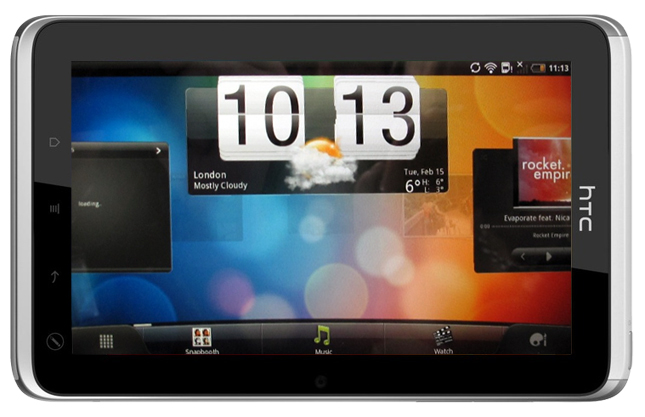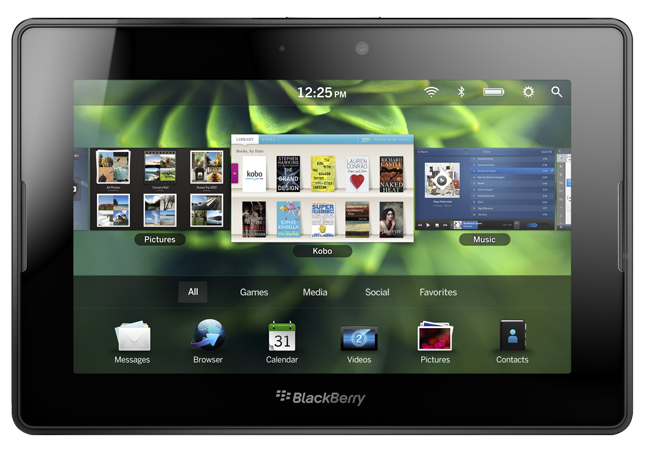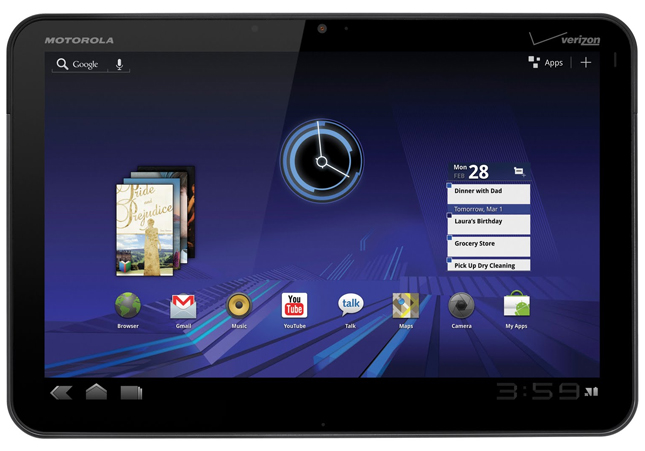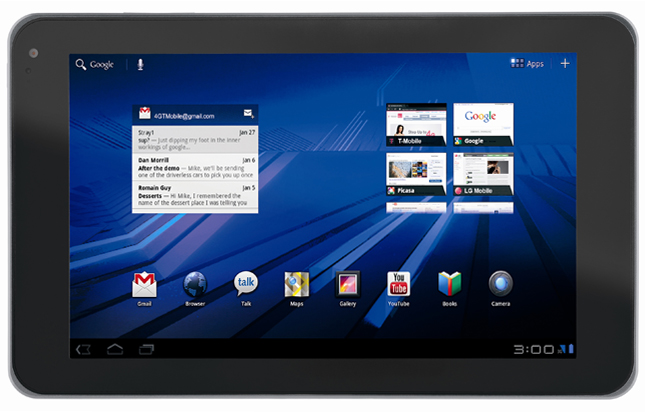Best tablets 2011
As you know, the iPad 2 came out on March 2, and after that the tablet set of 2011, I think, can be considered fully equipped - hardly anyone will soon release something else.

The main trends of this year, of course, are dual-core mobile processors and operating systems specially adapted for tablets. The first ones allow you to get sufficient performance for comfortable work (although, in order to squeeze the maximum out of them, the OS needs to be further optimized and optimized), and the latter increase the usability at times. All previous attempts to make tablet PCs a popular class of devices failed, in my opinion, due to the fact that vendors, without further ado, simply screwed touchscreens on laptops and left as is the good old Windows with an interface that was not designed at all. for poking fingers into it. Yes, and the current Windows 7, though much more thoughtful in this regard, is still primarily a desktop OS. New tablets, of course, are also not perfect, but I think this attempt can already be considered successful. At the first generation, manufacturers will clearly not stop, and next year we should expect new “pills”.
')
For myself, I chose the seven most interesting tablets and put them in places as follows: on the first iPad 2, HP Touchpad and HTC Flyer share the second, the BlackBerry PlayBook and Motorola XOOM also take the third, followed by the Samsung Galaxy Tab 10.1, and last place is LG G-Slate. I'll tell you why.
The Cupertins didn’t do anything revolutionary this time, they just updated the first model, making it competitive in terms of iron. Plus, iOS 4.3 rolled out, in which the browser's performance was improved and new wireless chips were added: streaming video over Wi-Fi and switching the device to router mode for other Apple devices. Everything else Apple already had: a great ecosystem and a very loyal audience. And yet, (who would have thought that this would ever happen!) Do not forget about the lowest price! None of the competitors sells tablets for $ 500. Tim Cook's efforts are not wasted - the company has a very tough pricing policy.

HP in a completely unexpected way showed a device that I, at least, really want to turn in my hands, and as a maximum - to buy. And the matter is not even in hardware (it is, perhaps, less impressive than in others), but in an excellent software that has been thought out to the smallest detail, which was released from the pen of the Palm. webOS is like a breath of clean air after a huge number of Android tablets. The most important thing is that this gadget (unlike some others, which are written below) may well be on sale in our country, and this is good news!

HTC has been on the market for only a few years, but has already firmly established itself in the minds of customers as a manufacturer of some of the best smartphones. In my opinion, they also went right with the tablets. Flyer, like the HP Touchpad, stands out from the rest with a special software - the tablet version of the Sense shell, which hides Android 2.3. Taiwanese have not yet become bother with the third “robot”, and this, apparently, will allow them to release the tablet to the market before the competition, and then smoothly switch to the third version of this OS. Plus, you should not forget about additional services like Onlive (a cloud gaming service that allows you to run complex 3D games on remote servers without using the tablet's hardware), which support was announced with the device. In general, despite the fact that many may be confused by a fast (1.5 GHz) processor, a small battery capacity and a rather high price, I think that the model has a great future - this brand already has its own, even if not as impressive as Apple has an army of fans.

The BlackBerry tablet also compares favorably with others in its software and integration with the company's services. The QNX operating system, on which the BlackBerry Tablet OS is based, is known for its stability, and the presentation made the most favorable impression by performing several tasks simultaneously. Until recently, everyone believed that this gadget would most likely never officially appear in Russia, but (surprise surprise!) According to the agency promoting BB in Russia, negotiations are underway with retailers to start selling this tablet in our market, pricing policy, etc. Everyone seems to be interested in this.

"Zoom" (the name is pronounced that way, and not "Xum") impresses first of all with its powerful hardware: NVIDIA Tegra 2, 1 gigabyte of RAM, a good dual flash camera. In general, a good thing! Plus, on this tablet, for the first time, the Android 3.0 interface was shown, and this name is in many people’s memory. However, unlike the PlayBook, it is unlikely to appear in our country, since Motorola (temporarily?) Left the Russian market. And it’s a pity - many people still remember various MOTOs with a kind word.

Samsung’s “tablet” in terms of stuffing is almost a complete analogue of XOOM, but unlike the “motoplanet”, it’s likely to be sold in Russia and will probably try to rectify the situation, because the company didn’t work with the first smaller diagonal model. Mainly, of course, due to inadequate price tag. It is hoped that this time they will approach this issue more wisely, because in general, the product turned out to be quite good and differs from other tablets on Android 3.0 with a large screen and weighty TTX. In any case, representatives of the company stated that, apparently, they would reconsider the pricing policy in connection with the release of the Apple “pill”, so that it wouldn’t work out like last time.

But the LG tablet turned out to be too experimental, in my opinion, and something suggests that it will not go beyond the exhibition stand, since there are not many people willing to pay many thousands of hard-earned rubles for dubious gadgets. It was rumored that there would be a 3D display, thank God they refused, showing only a three-dimensional communicator. But the 3D camera is available - it still raises the price, but in fact it doesn't come in handy enough. Were it not for these bells and whistles, the gadget would have been interesting from the practical side - after all, it was built on quite a promising platform NVIDIA Tegra 2. And so ... it seems they are too smart.

Unfortunately, the Habra editor does not support the iframe tag, so you need to embed a pivot table in the form of a clickable image. The link leads to a "live" Google document.

I re-read all this and realized that I put in the first places not those tablets that are “faster-higher-stronger”, but those that are distinguished by a more thoughtful software. Now without an ecosystem just nowhere! Who needs a powerful gadget in a vacuum? Everyone wants to use it, and not just carry it in a bag. And it is desirable that it is suitable immediately for work and for entertainment. Naked Android is not as interesting as licked to shine iOS, or as promising webOS, or as the same Sense, which turns the “tablet” from just a tablet into a tablet HTC. In this regard, I want to contact the manufacturers: enough to be measured with gigahertz and megapixels! Throw your strength on an interesting software!
I understand that many will find the absence of several interesting and promising devices in the text and table at first glance strange. I understand that business is not limited to these seven models, and if you wish, you can cram many more tablets into this list! But they all seem to me not as promising as the ones listed above, and of course there are reasons for that too. ASUS, for example, demonstrated several devices of the Eee Pad series at once. The brightest of them is the Transformer - either a tablet, or a laptop on Android 3.0, which has a keyboard unfastened. I'm not saying that this is bad, but I just don’t understand why I might need such a thing: the tablet has a tablet - it’s light, it’s more convenient to take it on the road, and the laptop has a laptop –– it’s comfortable to carry out “heavy” tasks and type . The same story with a ten-inch ViewSonic ViewPad, which in addition to Android, Windows is installed. I don’t understand why I need such a device, because Windows is at my home and at work on desktops - under this OS I perform specific tasks using the mouse and keyboard. And the younger seven-inch ViewPad model is running an unseen Android 2.2, which I consider to be a crime, since this version is not intended for tablets completely. And I wouldn't consider Dell Streak 7 seriously either because of the same Android 2.2. Thus, we again come up against the need to match the software with the hardware and the tasks that will be performed with their help. Something like this.

The main trends of this year, of course, are dual-core mobile processors and operating systems specially adapted for tablets. The first ones allow you to get sufficient performance for comfortable work (although, in order to squeeze the maximum out of them, the OS needs to be further optimized and optimized), and the latter increase the usability at times. All previous attempts to make tablet PCs a popular class of devices failed, in my opinion, due to the fact that vendors, without further ado, simply screwed touchscreens on laptops and left as is the good old Windows with an interface that was not designed at all. for poking fingers into it. Yes, and the current Windows 7, though much more thoughtful in this regard, is still primarily a desktop OS. New tablets, of course, are also not perfect, but I think this attempt can already be considered successful. At the first generation, manufacturers will clearly not stop, and next year we should expect new “pills”.
')
For myself, I chose the seven most interesting tablets and put them in places as follows: on the first iPad 2, HP Touchpad and HTC Flyer share the second, the BlackBerry PlayBook and Motorola XOOM also take the third, followed by the Samsung Galaxy Tab 10.1, and last place is LG G-Slate. I'll tell you why.
Apple iPad 2
The Cupertins didn’t do anything revolutionary this time, they just updated the first model, making it competitive in terms of iron. Plus, iOS 4.3 rolled out, in which the browser's performance was improved and new wireless chips were added: streaming video over Wi-Fi and switching the device to router mode for other Apple devices. Everything else Apple already had: a great ecosystem and a very loyal audience. And yet, (who would have thought that this would ever happen!) Do not forget about the lowest price! None of the competitors sells tablets for $ 500. Tim Cook's efforts are not wasted - the company has a very tough pricing policy.

HP Touchpad
HP in a completely unexpected way showed a device that I, at least, really want to turn in my hands, and as a maximum - to buy. And the matter is not even in hardware (it is, perhaps, less impressive than in others), but in an excellent software that has been thought out to the smallest detail, which was released from the pen of the Palm. webOS is like a breath of clean air after a huge number of Android tablets. The most important thing is that this gadget (unlike some others, which are written below) may well be on sale in our country, and this is good news!

HTC Flyer
HTC has been on the market for only a few years, but has already firmly established itself in the minds of customers as a manufacturer of some of the best smartphones. In my opinion, they also went right with the tablets. Flyer, like the HP Touchpad, stands out from the rest with a special software - the tablet version of the Sense shell, which hides Android 2.3. Taiwanese have not yet become bother with the third “robot”, and this, apparently, will allow them to release the tablet to the market before the competition, and then smoothly switch to the third version of this OS. Plus, you should not forget about additional services like Onlive (a cloud gaming service that allows you to run complex 3D games on remote servers without using the tablet's hardware), which support was announced with the device. In general, despite the fact that many may be confused by a fast (1.5 GHz) processor, a small battery capacity and a rather high price, I think that the model has a great future - this brand already has its own, even if not as impressive as Apple has an army of fans.

Blackberry playbook
The BlackBerry tablet also compares favorably with others in its software and integration with the company's services. The QNX operating system, on which the BlackBerry Tablet OS is based, is known for its stability, and the presentation made the most favorable impression by performing several tasks simultaneously. Until recently, everyone believed that this gadget would most likely never officially appear in Russia, but (surprise surprise!) According to the agency promoting BB in Russia, negotiations are underway with retailers to start selling this tablet in our market, pricing policy, etc. Everyone seems to be interested in this.

Motorola XOOM
"Zoom" (the name is pronounced that way, and not "Xum") impresses first of all with its powerful hardware: NVIDIA Tegra 2, 1 gigabyte of RAM, a good dual flash camera. In general, a good thing! Plus, on this tablet, for the first time, the Android 3.0 interface was shown, and this name is in many people’s memory. However, unlike the PlayBook, it is unlikely to appear in our country, since Motorola (temporarily?) Left the Russian market. And it’s a pity - many people still remember various MOTOs with a kind word.

Samsung Galaxy Tab 10.1
Samsung’s “tablet” in terms of stuffing is almost a complete analogue of XOOM, but unlike the “motoplanet”, it’s likely to be sold in Russia and will probably try to rectify the situation, because the company didn’t work with the first smaller diagonal model. Mainly, of course, due to inadequate price tag. It is hoped that this time they will approach this issue more wisely, because in general, the product turned out to be quite good and differs from other tablets on Android 3.0 with a large screen and weighty TTX. In any case, representatives of the company stated that, apparently, they would reconsider the pricing policy in connection with the release of the Apple “pill”, so that it wouldn’t work out like last time.

LG G-Slate
But the LG tablet turned out to be too experimental, in my opinion, and something suggests that it will not go beyond the exhibition stand, since there are not many people willing to pay many thousands of hard-earned rubles for dubious gadgets. It was rumored that there would be a 3D display, thank God they refused, showing only a three-dimensional communicator. But the 3D camera is available - it still raises the price, but in fact it doesn't come in handy enough. Were it not for these bells and whistles, the gadget would have been interesting from the practical side - after all, it was built on quite a promising platform NVIDIA Tegra 2. And so ... it seems they are too smart.

Nameplate
Unfortunately, the Habra editor does not support the iframe tag, so you need to embed a pivot table in the form of a clickable image. The link leads to a "live" Google document.

Summary
I re-read all this and realized that I put in the first places not those tablets that are “faster-higher-stronger”, but those that are distinguished by a more thoughtful software. Now without an ecosystem just nowhere! Who needs a powerful gadget in a vacuum? Everyone wants to use it, and not just carry it in a bag. And it is desirable that it is suitable immediately for work and for entertainment. Naked Android is not as interesting as licked to shine iOS, or as promising webOS, or as the same Sense, which turns the “tablet” from just a tablet into a tablet HTC. In this regard, I want to contact the manufacturers: enough to be measured with gigahertz and megapixels! Throw your strength on an interesting software!
P.S
I understand that many will find the absence of several interesting and promising devices in the text and table at first glance strange. I understand that business is not limited to these seven models, and if you wish, you can cram many more tablets into this list! But they all seem to me not as promising as the ones listed above, and of course there are reasons for that too. ASUS, for example, demonstrated several devices of the Eee Pad series at once. The brightest of them is the Transformer - either a tablet, or a laptop on Android 3.0, which has a keyboard unfastened. I'm not saying that this is bad, but I just don’t understand why I might need such a thing: the tablet has a tablet - it’s light, it’s more convenient to take it on the road, and the laptop has a laptop –– it’s comfortable to carry out “heavy” tasks and type . The same story with a ten-inch ViewSonic ViewPad, which in addition to Android, Windows is installed. I don’t understand why I need such a device, because Windows is at my home and at work on desktops - under this OS I perform specific tasks using the mouse and keyboard. And the younger seven-inch ViewPad model is running an unseen Android 2.2, which I consider to be a crime, since this version is not intended for tablets completely. And I wouldn't consider Dell Streak 7 seriously either because of the same Android 2.2. Thus, we again come up against the need to match the software with the hardware and the tasks that will be performed with their help. Something like this.
Source: https://habr.com/ru/post/115154/
All Articles